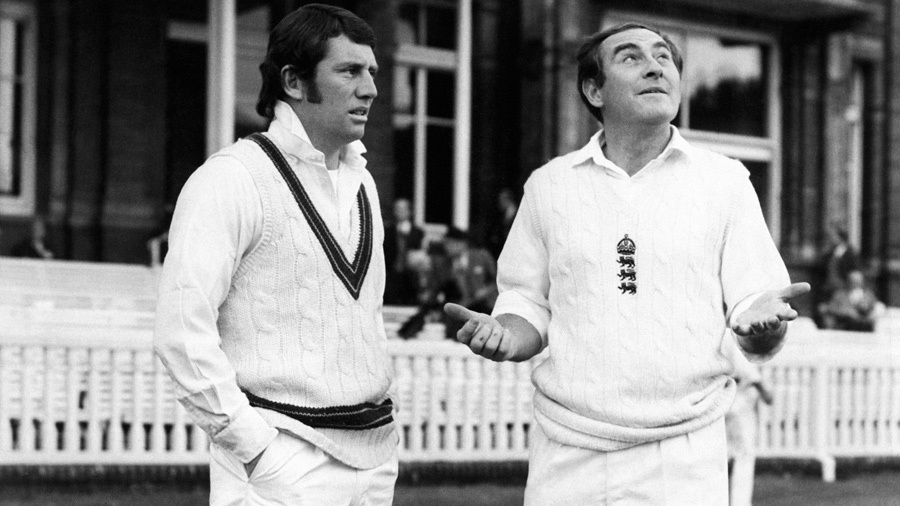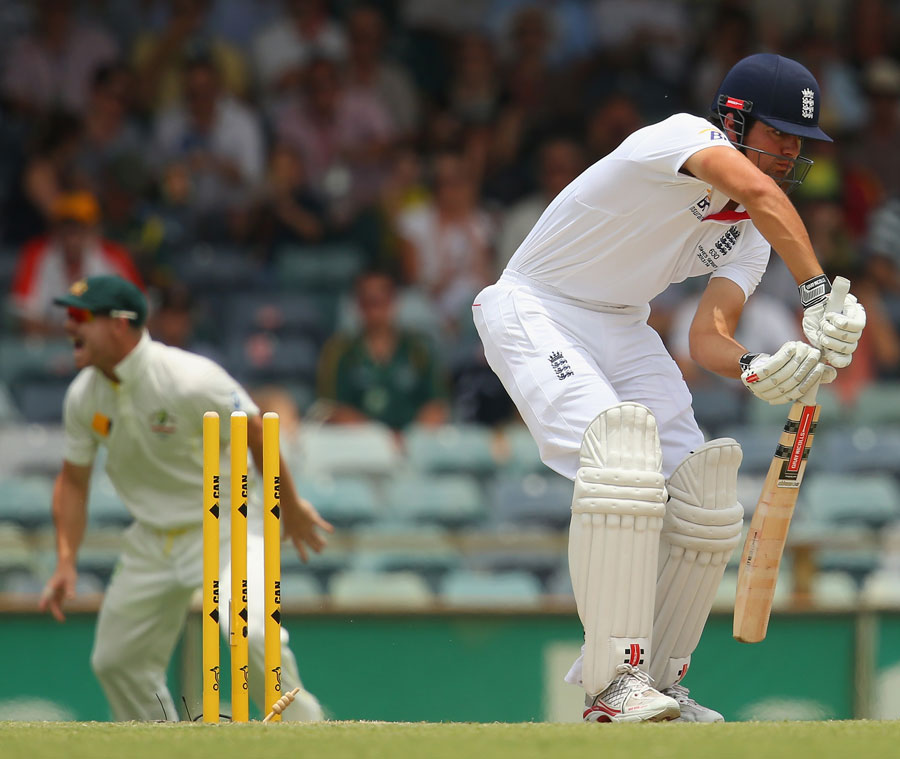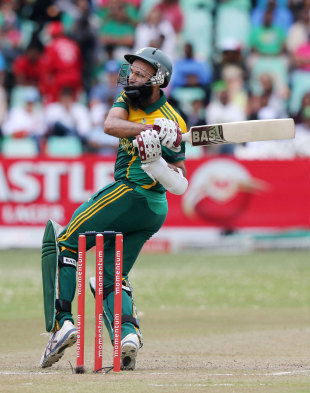 James Anderson: one of many who have questioned why more fast bowlers aren't considered for captaincy © Getty Images
James Anderson: one of many who have questioned why more fast bowlers aren't considered for captaincy © Getty ImagesJames Anderson has nothing to prove to anyone but, one assumes, himself. Nor is he one to mince words. So when he expresses disappointment at not having been considered for the England Test captaincy, then says he doesn't know why more fast bowlers aren't entrusted with leadership, and leaves the question hanging in the air, the point is worth considering. What possible reason can there be to maintain the lazy, prejudiced, time-dishonoured view that batsmen should be the default choice as coin-tossers?
Naturally, the record books tell their own flagrantly biased story: of the 57 men to have captained in 25 or more Tests, 46 have been batsmen first and foremost (including 15 of the 16 who have done so on 50-plus occasions, the exception being MS Dhoni). Even if we include two top-notch allrounders, Imran Khan and Garry Sobers, the number of seam bowlers runs to just six: Imran (48 Tests), Sobers (39), Kapil Dev (34), Darren Sammy (30), Shaun Pollock (26) and Wasim Akram (25). Still, that's twice as many representatives in the chart as the spin fraternity can muster - Daniel Vettori (32), Ray Illingworth (31) and Richie Benaud (28) - never mind the stumpers, who contribute only Dhoni (60) and Mushfiqur Rahim (30). As for those who would classify him as a spinner, Sobers is remembered better by this column for his left-arm swing than his spin, so let's indulge it.
It gets worse. Late last year the Cricketer magazine asked readers to vote for their favourite England captain; of the 23 candidates proffered, only Illingworth did not count run-making as his primary occupation. It's all a matter of class, of course. Back when such distinctions were made, the amateurs were almost invariably batsmen, cravat-wearing types accustomed to being served hittable offerings by lowly, gnarly professionals; chaps to whom authority was a birthright. "In England," noted Mike Brearley in his definitive The Art of Captaincy, a revised edition of which is due out this summer, "charisma and leadership have traditionally been associated with the upper class; with that social strata that gives its members what Kingsley Amis called 'the voice accustomed to command'."
If Anderson is "all for bowlers being captains", Don Bradman offered the counter-argument in The Art of Cricket, reasoning that they would lack objectivity about their own workload. "They tend either to over-bowl themselves or not to bowl enough," reinforced Brearley, "from conceit, modesty or indeed self-protection." On the other hand, he continued, two of the best postwar captains in his view were Benaud and Illingworth, outliers both.
It's all a matter of class, of course. Back when such distinctions were made, the amateurs were almost invariably batsmen, cravat-wearing types accustomed to being served hittable offerings by lowly, gnarly professionals
In his 1980 book Captaincy, Illingworth argued that the allrounder, and especially those who were also twirlers like himself and Benaud, were the best equipped for the job. He also took issue with Bradman in his autobiography Yorkshire and Back:
"Basically, I felt my two strongest points were, first, after playing for quite a time I knew batsmen pretty well and I knew their temperaments so I thought I set good fields; and second, I think I was able to get the best out of people because they trusted me. I knew when to attack and when to defend, which governed field placing, and my handling of the bowling."
Video has aided such knowledge, granted, but there's no substitute for a bowler's instinct.
Benaud also rated Illingworth high above the herd. In his 1984 book, Benaud of Reflection he wrote:
"He was a deep thinker on the game, without having any of the theories which sometimes produce woolly thinking from captains. He was a shrewd psychologist and one who left his team in no doubt as to what he required of them. Above all, though, he made his decisions before the critical moment. It was never a case of thinking for an over or two about whether or not a move should be made. If he had a hunch it would work, and if it seemed remotely within the carefully laid-down plans of the series, then he would do it."
What counted above all, felt Illingworth, under whose charge England enjoyed most of their record 26-match unbeaten run between 1969 and 1971, was honesty. During the summer of 1970, opener Brian Luckhurst asked him, somewhat tentatively, whether he had any chance of being picked for that winter's Ashes tour, having made a fair few runs in the first three Tests of the series against a powerful Rest of the World attack. "You're almost on the boat now," replied Illy. "Now what I liked about that," he recollected, "was that Brian had only played three matches with me, and yet he felt that not only could he ask a question, but he was reasonably sure he'd get an honest answer."
Ah, but what if the truth had been, in the captain's view, that Luckhurst was nowhere near the boat? "I wouldn't have told him, 'You've no bloody chance.' I like to think it is possible to be less brutal than that while being sincere, but I would have told him straight that his chances were slim, or even less than that."
 Ray Illingworth (right): "I felt my two strongest points were, first, after playing for quite a time, I knew batsmen pretty well, so I thought I set good fields; and second, I think I was able to get the best out of people" © PA Photos
Ray Illingworth (right): "I felt my two strongest points were, first, after playing for quite a time, I knew batsmen pretty well, so I thought I set good fields; and second, I think I was able to get the best out of people" © PA PhotosSo, knowledge of batsmen, intelligence, psychological insight and honesty: all assets that Anderson possesses, and has employed in support of his captains. Unlike most fast bowlers, moreover, he fields in the slips - one of the better vantage points, if perhaps overrated. He says he enjoyed leading Lancashire on a pre-season tour but acknowledges that, as a fast bowler of advanced age, promoting him now would have made little sense. And yes, if we're brutally honest, had the vacancy arisen, say, three years ago, it is questionable whether he could have been relied upon to control the flashes of temper that have occasionally plunged him into hot water.
Brearley, for his part, contended that a fast bowler should only ever be made captain as a last resort. "It takes an exceptional character to know when to bowl, to keep bowling with all his energy screwed up into a ball of aggression, and to be sensitive to the needs of the team, both tactically and psychologically. [Bob] Willis in particular always shut himself up into a cocoon of concentration and fury for his bowling." The exception, he allowed, was Mike Procter. "Vintcent van der Bijl, who played under Procter for Natal, speaks of his ability to develop each player's natural game and of the enthusiasm that he brought to every match."
Benaud disagreed with Brearley, hailing Keith Miller, a fast bowling allrounder, as the best captain he played under. "No one under whom I played sized up a situation more quickly and no one was better at summing up a batsman's weaknesses," Benaud wrote. "He had to do this for himself when he was bowling and it was second nature for him to do so as captain."
Unaccountably to many, while his tenure as New South Wales captain kicked off a run of nine consecutive Sheffield Shield titles, the nearest Miller came to leading his country was when he took over from the injured Ian Johnson for the first Test of the 1954-55 Caribbean tour in Jamaica, which saw him handle his attack astutely over both West Indies innings, score a century and grab five wickets.
Brearley, for his part, contended that a fast bowler should only ever be made captain as a last resort
Naturally, it is pure conjecture as to whether Australia would have fared better under him on the 1956 Ashes tour - Johnson, a so-so offspinner but the establishment man, was again preferred. There seems to be no better explanation for Miller being passed over than that the selectors were fearful that, as a free spirit and renowned party animal in an image-obsessed trade, he might project the wrong one. "I never seriously thought I would be the captain," Miller would reflect. "I'm impulsive; what's more, I've never been Bradman's pin-up." Nearly half a century later, Shane Warne suffered similarly.
Anderson's main thrust, nonetheless, was about bowlers in general. So, is it fair to say that selectors and committees are still blinded by tradition? Not remotely as much as they were. That two-thirds of the longest-reigning Test bowler-captains (and both wicketkeeper-captains) have assumed charge in the post-Packer age seems far from coincidental.
As Tests have proliferated and media scrutiny has soared, so appointing the right man has never been more important; shelving reservations based on ritual has become equally crucial, as evinced most recently by the appointments of Rangana Herath (Sri Lanka), Jason Holder (West Indies) and Graeme Cremer (Zimbabwe) - one of whom, Holder, is a remarkably young fast bowler, albeit not a furiously aggressive specimen. Nevertheless, at a time when central contracts have placed pre-international captaincy experience at an ever-scarcer premium, this open-mindedness, such as it is, must gain pace.
Whatever the future may bring, there is only one certainty: there will never be another Brearley, another accomplished strategist, deep thinker and wise leader of men otherwise unworthy of his place. All the more reason, then, for that revised version of The Art of Captaincy to be mandatory bedtime reading for Joe Root.


